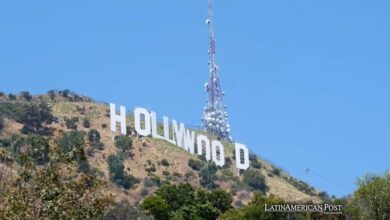Beyond Spider-Man: 5 Animated Movies That Changed Movie History
On the occasion of the premiere of "Spider-Man: Through the Spider-Verse" and its classification as a revolutionary film for animation, we remember the five animated works that changed the history of cinema.

Photos: HBO Max, Disney+
LatinAmerican Post | Juan Andrés Rodríguez
Escucha este artículo
Leer en español: Más allá de Spider-Man: 5 películas animadas que cambiaron la historia del cine
Director Guillermo del Toro says, “Animation is a medium, not a genre. It is the most beautiful and complete way of managing creation”. Del Toro, a recent Oscar winner for his stop-motion version of "Pinocchio" (2022), is one of the most visible voices of a movement in the industry that for years has advocated recognition of the complexity of animation techniques and his contribution to the consolidation of cinema as an artistic expression. Although examples are not lacking, the premiere of "Spider-Man: Through the Spider-Verse", a sequel to the acclaimed 2018 film, is the perfect reminder of the validity and importance of this argument.
The original film featured the first film version of Miles Morales' Spider-Man and his encounter with many variants of the spider-hero following a multiversal coalition. It gained recognition for his revolutionary style that mixes CGI with 2D to recreate the look and feel of a comic book and create an immersive environment.
The second part of a trilogy that is already cementing its status in the annals of cinema elevates this concept by employing six styles of animation in action sequences so complex they took four years to complete. The result is an incredible experience that pays homage to animation in all its formats. On the occasion of this event, we recall some works (short and feature films) that have innovated in the techniques of this medium, changing the standards of what is possible in cinema to take imagination on the visual to new levels.
"Fantasmagorie" (1908)
Granting the title of "first" tends to minimize the process of centuries and decades for that result to be possible. For this reason, before classifying a tape as "the first animated film", it should be noted that the beginnings of animation go back hundreds of years with puppets and shadow theaters. This then went through very important advances in the second half of the 19th century with the invention of the phenakistiscope and the zoetrope, disc- or drum-shaped machines that gave the illusion of movement.
All these inventions would be fundamental not only for animation, but for the creation of cinema itself by establishing the foundations of speed image sequencing. It took 13 years from the "invention of cinema" with the Lumiere cinematograph to record the first animated cartoon on tape: "Fantasmagorie" by Émile Coh. The 1 minute and 17 second sequence is the result of 700 hand-drawn images, showing the metamorphosis of people and objects, an allegorical style of 19th-century lantern theater.
"Steamboat Willie" (1928)
In 1927 the history of cinema changed with the premiere of the first film with synchronized sound. The following year, in a less prominent but important act, “Steamboat Willie,” directed by Walt Disney with Ub Iwerks, was one of the first cartoons with synchronized sound and the debut of the Walt Disney Animation Studios icon. The popularity of those 7 minutes and 23 seconds at the West 57th Theater in New York changed the course of the medium.
The success of the short film was key to Disney presenting its version of "Snow White and the Seven Dwarfs" in 1937, considered the first animated film (although that title is in dispute with "The Apostle", an Argentine production from 1917). These were the foundations of an industrial titan that monopolized animation and can be credited with associating with a child audience. In 2024 the work will become public domain.
Also read: "Spider-Man: Across the Spiderverse", an Animation Masterpiece
"The Castle of Cagliostro" (1979)
The first anime works date back to 1917 and were key to improving the cel animation technique, with state support for filmmakers. That alliance consolidated the style as an icon of Japanese culture, with the curiosity that the first anime feature film, "Momotarō, God of Waves" (1944), was made with the support of the Japanese Imperial Army.
But there is a fundamental anime that even for the most well-versed moviegoers, it will be difficult to recognize. "The Castle of Cagliostro" is the second film based on the Lupine III manga and its importance lies in being the directorial debut of Hayao Miyazaki, the co-founder and flagship director of Studio Ghibli. Although it was a disappointment at the box office during its premiere, over time its influence has been recognized for great filmmakers such as Steven Spielberg, George Lucas and John Lasseter, co-founder of Pixar and who credits the film with a crucial role in his career. It is a work that from the beginning gave a differentiating touch to Miyazaki's works, which brought anime to international recognition with titles such as "Spirited Away" (2001).
Who Framed Roger Rabbit? (1988)
The mixture of animation and "live-action" has a long history in the cinema. Films like “The Lost World” (1925) and “King Kong” (1933) popularized the inclusion of stop-motion sequences to represent fights with monsters, and in 1964 Disney once again set precedents with the animated sequences of Mary Poppins. But it was the Robert Zemeckis classic “Who Framed Roger Rabbit?” that demonstrated the potential of the hybrid style.
It is a detective story in a world where cartoons interact with humans. Zemeckis led a team that broke the bar by betting on realistic interactions of the actors with the animated characters and environments. This made him a pioneer in the use of motion capture and the development of a technology that would later be used to film films such as the "Lord of the Rings" trilogy and "Avatar" (2009).
Toy Story (1995)
Almost 90 years after that first film with a cartoon, a film was released with an interesting concept and a brilliant idea. Toys that came to life and for that, computer images (CGI) were generated. Pixar's founding film gets credit for introducing the technology that gave rise to modern visual effects.
This is a brief history by animated cinema. We believe that all of these are up to the task, and they have also been predecessors of "Spider-Man: Through the Spider-Verse", which are your favorites?




